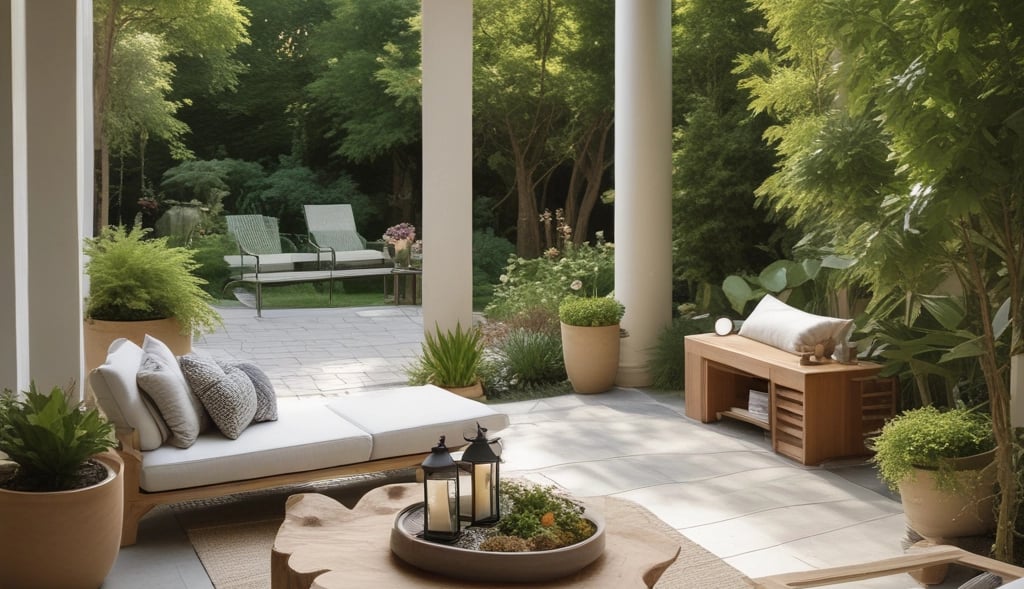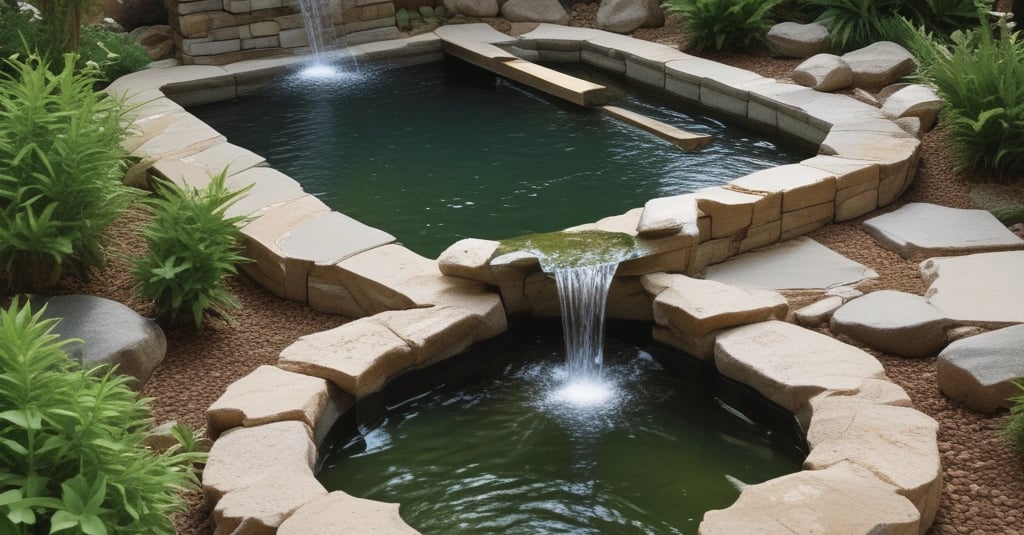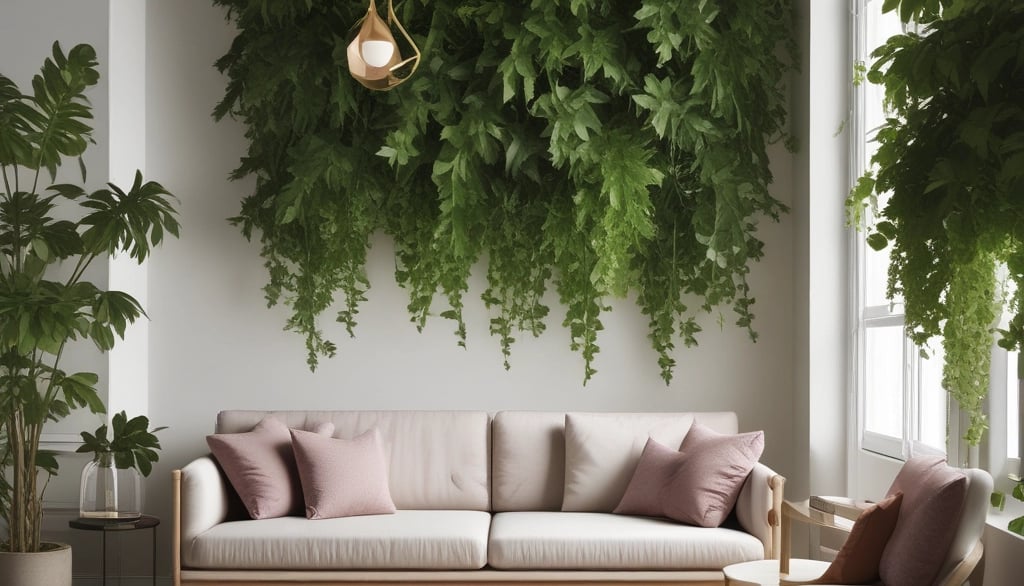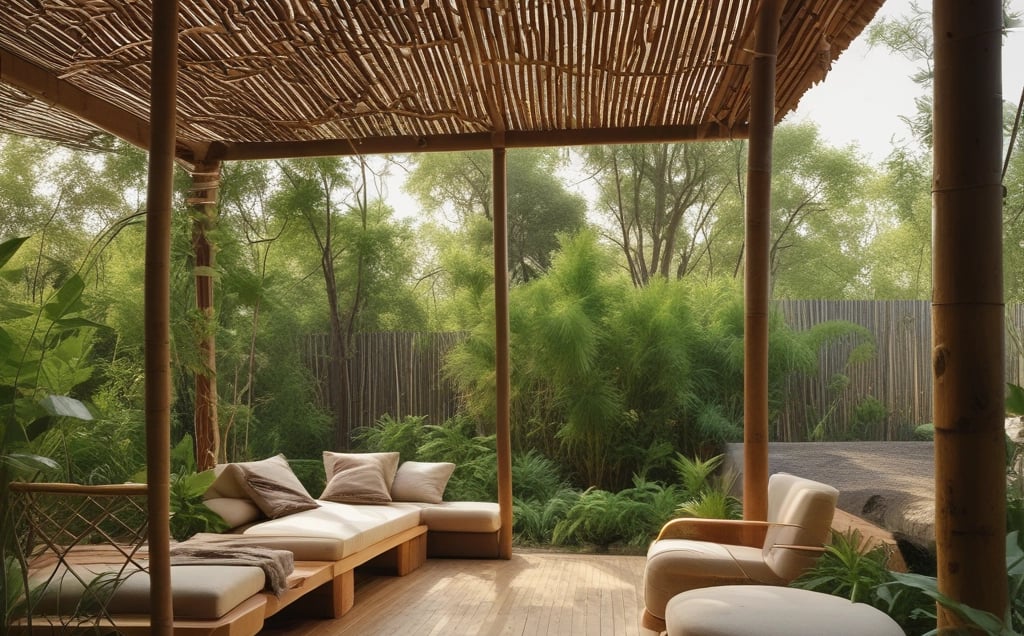Creating Your Serene Outdoor Retreat: A Guide to Tranquil Spaces
HOME DESIGN IDEAS
Mohamed Amine
10/20/202512 min read
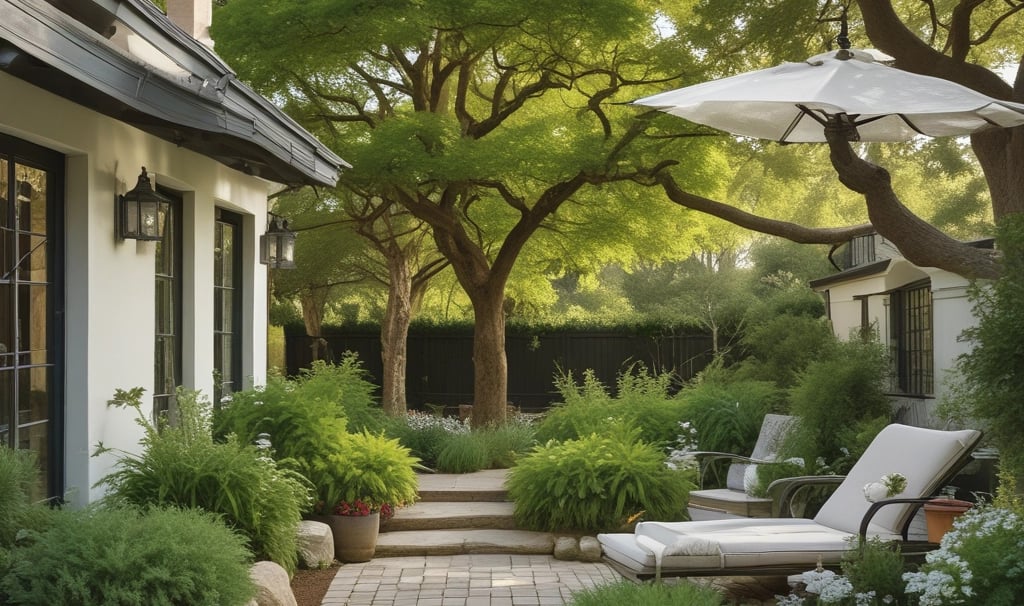

Designing Tranquility: The Essence of Outdoor Serenity
Creating a serene outdoor retreat requires an understanding of the foundational principles that contribute to a peaceful atmosphere. The essence of outdoor serenity resides in harmonizing the various elements of design, such as layout, color schemes, and the integration of natural features. By thoughtfully considering these aspects, one can design a space that promotes relaxation and mindfulness.
The layout of the retreat is crucial in fostering a sense of tranquility. Open spaces that allow for easy movement and clear sightlines can enhance the feeling of freedom and connection to nature. Incorporating different zones for various activities, such as meditative areas, seating arrangements, and natural pathways, enables users to engage with the space at their own pace. These zones should encourage the exploration of the surroundings while maintaining an overarching sense of cohesion.
Color schemes play an equally important role in establishing a tranquil environment. Earthy tones, such as greens, browns, and soft blues, are effective in creating a soothing backdrop that complements the natural landscape. These colors can be integrated through landscaping choices, furniture selections, or decorative elements. Additionally, incorporating natural materials like wood and stone can enhance the aesthetic appeal and ensure that the design aligns with the principles of sustainability.
Finally, the importance of creating a space that promotes relaxation and mindfulness cannot be understated. Integrating elements such as water features, which can provide a calming sound, or gardens filled with fragrant plants, can enhance the sensory experience. Employing design techniques that focus on the harmony between outdoor spaces and nature truly sets the tone for the entire retreat, encouraging individuals to unwind and embrace the beauty of their surroundings. By considering these essential elements, one can create an outdoor retreat that serves as a perfect sanctuary for serenity.
Natural Elements That Inspire Calm and Balance
Integrating natural elements into outdoor spaces can profoundly enhance the atmosphere, promoting tranquility and balance. Nature has an inherent ability to soothe the mind and rejuvenate the spirit. By incorporating materials such as stones, water, and wood, one can create a serene outdoor retreat that fosters peace and relaxation.
Stones, for instance, are a versatile element that can serve both functional and aesthetic purposes in outdoor design. They can be used to create pathways or fire pits, offering both a tactile experience and a visual anchor within the landscape. The raw textures of stone surfaces evoke a sense of timelessness and permanence, drawing on natural beauty that encourages a meditative state. Additionally, stone can retain heat from the sun during the day and release it in the evening, contributing to a comfortable outdoor environment.
Water features are another essential component in crafting a tranquil space. The soothing sound of bubbling water can drown out unwanted noise while inspiring a sense of calm. Options range from small fountains to larger ponds, each offering distinct ways to engage the senses. The reflective qualities of water not only enhance visual aesthetics but also promote mindfulness as one observes the ever-changing surface, reinforcing the connection to nature.
Wood is also an important natural element that instills warmth and comfort. Whether used in furniture, decking, or garden structures, the organic nature of wood creates an inviting atmosphere. Its natural grains and hues harmonize beautifully with other components of outdoor design, fostering a sense of unity and balance within the space. In addition, incorporating greenery through trees and plants enhances biodiversity and connection to the earth, adding layers of color and life.
Ultimately, the combination of these natural elements can result in an outdoor retreat that not only serves as a personal sanctuary but also promotes overall well-being. By thoughtfully selecting and integrating stones, water, and wood, one can cultivate an environment ripe for reflection, mindfulness, and peace.
Creating Harmony with Landscape and Architectur
When establishing a serene outdoor retreat, merging architectural designs with landscape features is crucial to achieving a harmonious and cohesive look. The synergy between built structures and their surrounding environment can significantly enhance the aesthetic and tranquil qualities of the space. This integration requires careful planning and consideration of various elements, including materials, colors, and spatial relationships.
Architectural elements should complement the existing landscape rather than dominate it. For instance, using natural materials such as stone, wood, or even bamboo can create a seamless transition from the built environment to nature. These choices not only promote visual harmony but also blend the structures with the ecosystem, making them appear as if they have organically evolved within their surroundings. Moreover, color palettes that reflect the natural landscape can further enhance this blend, ensuring that structures do not clash with the earth tones of the garden or the vibrant hues of surrounding flora.
Furthermore, the layout of both landscaping and architecture plays a critical role in establishing a tranquil environment. Creating outdoor spaces that facilitate smooth movement and allow for clear sightlines can enhance the sense of openness and flow. This can be achieved through the thoughtful positioning of walkways, patios, and plant arrangements. Incorporating features such as water elements, seating areas, and shaded retreats can create focal points and intimate nooks, inviting visitors to relax and immerse themselves in the serene atmosphere.
Finally, the consideration of seasonal changes is vital when designing your outdoor retreat. Selecting a mix of evergreen plants along with seasonal blooms ensures that the landscape remains vibrant all year round, thus maintaining harmony with architectural features regardless of the season. By embracing these principles, one can cultivate a balanced outdoor space that embodies tranquility and fosters a deep connection with nature.
Comfortable Outdoor Furniture for Relaxation and Style
Creating a serene outdoor retreat hinges significantly on selecting the right outdoor furniture. Comfort should be paramount, as this will influence the extent to which your outdoor space can be enjoyed. However, the aesthetic appeal of the furniture cannot be overlooked, as it contributes to the overall atmosphere of tranquility and relaxation.
When considering outdoor furniture, various materials offer distinct benefits. For instance, teak is a highly durable hardwood that not only withstands the elements but also develops a beautiful silver-gray patina over time. Its natural oil content makes it resistant to decay, making it an excellent choice for long-lasting comfort and style. Alternatively, aluminum furniture, often powder-coated, is lightweight and resistant to rust, making it suitable for easy rearrangement while maintaining a modern aesthetic.
In addition to materials, the style of the furniture plays a crucial role in enhancing the relaxing ambiance of your outdoor retreat. For instance, lounge chairs with deep seating and plush cushions invite you to sink in and unwind. Consider sectional sofas for larger spaces, as they provide ample seating while fostering a laid-back atmosphere perfect for social gatherings or quiet moments alone. Furthermore, incorporating multifunctional pieces such as ottomans or side tables can add versatility to your outdoor furniture arrangement, allowing you to customize your space for various activities, from reading a book to enjoying a cocktail with friends.
Color is another important aspect when choosing outdoor furniture. Soft, muted tones can create a calming effect, while natural materials and organic shapes enhance the connection to nature. Overall, the selection of comfortable outdoor furniture not only impacts the functionality of your serene retreat but also helps cultivate a space where relaxation can flourish.
Water Features That Soothe the Senses
Incorporating water features into your outdoor space can significantly enhance the tranquility and serenity of your environment. The gentle sound of flowing water, along with the visual appeal of various water elements, contributes to a calming atmosphere, making them a valuable addition to your serene retreat. There are several types of water features that can be integrated into your landscape design, each providing unique sensory benefits.
One popular option is a garden fountain. Fountains come in various styles and sizes, allowing home owners to select one that complements their existing decor. The soothing sound of cascading water creates a peaceful backdrop, helping to drown out unwanted noise, such as traffic or neighborhood activities. A fountain can also attract local wildlife, such as birds and butterflies, further enhancing the tranquil ambiance of your outdoor space.
Ponds are another excellent way to incorporate water into your serene retreat. A pond can serve as a focal point in your garden, surrounded by lush plant life that encourages relaxation. Ponds provide a natural habitat for aquatic plants and fish, promoting biodiversity while fostering a sense of peace. The gentle lapping of water against the shore or the soft sounds of frogs can contribute to an immersive experience, engaging your senses and promoting tranquility.
Additionally, natural streams or watercourses can be integrated into larger landscapes, allowing for a more dynamic and organic feel. The visual flow of water, combined with the rhythmic sounds it produces, can create a meditative environment perfect for reflection and relaxation. Natural materials, such as stones and driftwood, can be used to enhance the aesthetic appeal and make the feature feel more integrated with the surrounding nature.
By thoughtfully incorporating these water features, you can create a soothing atmosphere that encourages relaxation and mindfulness, ultimately enhancing your overall outdoor experience.
The Role of Lighting in Evening Ambiance
Lighting plays a crucial role in establishing a serene outdoor retreat during the evening hours. As the sun sets, the right lighting options not only enhance the aesthetic appeal of outdoor spaces but also evoke feelings of calm and tranquility. Incorporating various types of lighting ambient, task, and accent can create a peaceful atmosphere suitable for relaxation and leisure.
Ambient lighting serves as the foundation for evening illumination. It provides general visibility without causing harsh glares or shadows. Soft, diffused lights such as lanterns, string lights, or solar-powered path lights can envelop the space in a gentle glow, ensuring that it remains inviting and comfortable. The warmth of these lights is particularly important in creating a cozy environment where one can unwind and enjoy nature’s beauty.
Task lighting is equally essential, particularly in designated areas for activities such as dining or reading. This type of lighting is brighter and more focused, allowing for functionality in these spaces. Outdoor table lamps, mounted lights, or even well-placed overhead fixtures can provide the necessary illumination for enjoyable activities while maintaining a harmonious atmosphere. Thoughtful placement ensures that these lights do not disrupt the overall soothing ambiance.
Accent lighting, on the other hand, is used to highlight specific features within the outdoor environment, such as trees, garden sculptures, or water features. This type of lighting adds depth and character to the space, drawing attention to the beauty of nature. By using low-voltage LED spotlights or recessed lighting installed in the landscape, home owners can create focal points that enhance the tranquil experience, making the outdoor retreat not just functional, but visually captivating as well.
By thoughtfully combining ambient, task, and accent lighting, one can successfully create a balanced evening ambiance that fosters relaxation and serenity. The careful selection and arrangement of these lighting types is essential for achieving a tranquil outdoor retreat as night descends.
Using Plants and Greenery for a Peaceful Atmosphere
Creating a serene outdoor retreat hinges on the thoughtful selection and placement of plants and greenery that foster an atmosphere of tranquility. The presence of plants not only enhances the aesthetic appeal of a space but also contributes significantly to emotional well-being. When choosing plants for a calming environment, consider species known for their soothing qualities. For instance, lavender is renowned for its calming fragrance, which can alleviate stress and promote relaxation. Similarly, bamboo is not only visually soothing with its gentle sway in the breeze but also offers a sense of privacy and seclusion.
In addition to individual plant selections, the layout of your greenery plays a pivotal role in establishing a peaceful setting. Strategic landscaping can help create zones of tranquility within your outdoor space. For example, clustering low-maintenance ground cover plants, such as creeping thyme, can create soft transitions between pathways and seating areas, thus encouraging visitors to slow down and enjoy their surroundings. Incorporating vertical gardens or trellises adorned with climbing vines can also provide visual interest and contribute to the sense of enclosure that enhances relaxation.
It is essential to consider the overall balance and harmony of your plant choices. A mix of tall and short plants can create layers that mimic natural landscapes and evoke feelings of comfort. Furthermore, incorporating native plants into your design not only supports local ecosystems but also reduces maintenance efforts, allowing you to enjoy your serene retreat without excessive labor. Overall, the right combination of plant species and thoughtful placement will undeniably transform your outdoor space into a haven of peace and relaxation, inviting you to unwind and rejuvenate in nature’s embrace.
Minimalist Decor for a Clean, Open Feel
In the pursuit of creating a serene outdoor retreat, the principles of minimalist decor play a pivotal role in fostering a tranquil environment. Minimalism, at its core, encourages the use of simple forms, uncluttered spaces, and intentional design choices that resonate with the beauty of nature. This design philosophy emphasizes that less truly can mean more, particularly in outdoor settings where the intention is to connect with one’s surroundings, promoting relaxation and peace.
One of the fundamental tenets of minimalist design is the reduction of excess. In an outdoor retreat, this translates to selecting furniture and decor that serve dual purposes or contribute to a cohesive aesthetic without overwhelming the senses. For instance, opting for a few well-chosen pieces such as a sleek bench or a simple table can create an inviting space while maintaining an open feel. Furniture should be chosen with care, ensuring it blends harmoniously with the natural landscape. Materials like wood, stone, and metals can provide both durability and a touch of elegance, aligning with the earthy tone typical of minimalist outdoor spaces.
Color palettes in minimalist design also contribute significantly to achieving a serene retreat. Neutral tones such as whites, grays, and soft earth hues help in creating a calming backdrop that enhances the natural beauty around the space. Incorporating greenery through potted plants or carefully selected landscaping can break the monotony while adhering to the minimalist ethos of simplicity and function. Additionally, sparse decorative elements, such as a single sculpture or a few select candles, can provide visual interest without obstructing the tranquility that minimalism seeks to foster.
Ultimately, embracing a minimalist approach in your outdoor retreat cultivates an area that invites relaxation and reflection, reinforcing the notion that simplicity often holds the key to serenity.
Privacy and Seclusion in Your Outdoor Escape
Creating a serene outdoor retreat necessitates a focus on privacy and seclusion. Such solitude is essential for cultivating an atmosphere where one can reflect, relax, and reconnect with nature. Achieving this can be a thoughtful process, involving various landscaping techniques, fencing options, and layout strategies that work together harmoniously.
One effective strategy to enhance privacy in your outdoor space is through thoughtful landscaping. Planting trees, shrubs, and tall grasses can serve as natural barriers, providing essential coverage from prying eyes. Opt for evergreen plants, which maintain their foliage year-round, ensuring consistent seclusion regardless of the season. It is advisable to select native species that thrive in your environment, as they typically require less maintenance and can adapt efficiently to local growing conditions.
Fencing is another valuable option for establishing a secluded retreat. Wood, vinyl, or ornamental metal fencing can create a sturdy perimeter that defines your outdoor escape while providing both security and privacy. When choosing fencing, consider the style and height that will best serve your design intent without obstructing your view. Combining various materials adds visual interest and texture while still maintaining the necessary aspect of seclusion.
Furthermore, the strategic layout of your outdoor space significantly influences how private it feels. Consider zoning your area into distinct sections for different functions such as lounging, gardening, or dining using pathways, borders, or changes in elevation to create an illusion of separation. Incorporating features like trellises adorned with climbing plants can also enhance privacy, defining spaces while enhancing the overall aesthetic.
By integrating these elements thoughtfully, you can transform your outdoor area into a peaceful sanctuary that prioritizes privacy and allows for relaxation, meditation, or simply enjoying nature undisturbed.
Sustainable Choices for Eco-Friendly Outdoor Design
Embracing eco-friendly outdoor design is essential for promoting sustainability while creating serene spaces. The objective is to utilize materials and practices that not only enhance the beauty of your outdoor area but also minimize the ecological footprint. One of the foremost strategies is selecting sustainable materials. For instance, consider using locally sourced timber, which reduces transportation emissions and supports local economies. Further, bamboo is an environmentally friendly option, as it is a fast-growing plant that can be harvested without causing long-term damage to the ecosystem.
Additionally, recycled materials can serve as excellent options for building and furnishing outdoor spaces. Items such as reclaimed wood, recycled metal, and repurposed bricks can add character and charm while conserving resources. The use of permeable paving in pathways and patios not only allows for natural water drainage but also helps in reducing runoff, contributing to a healthier environment.
Water conservation is another critical aspect of eco-friendly outdoor design. Implementing rainwater harvesting systems can provide a sustainable water source for irrigation, thereby minimizing reliance on municipally supplied water. Using native plants in landscaping is also a prudent choice, as these species require less water and are better adapted to local soil and climate conditions. This practice not only lessens water consumption but also supports local wildlife, which in turn creates a harmonious ecosystem.
Moreover, integrating renewable energy solutions, such as solar panels or solar-powered lighting, can serve as an energy-efficient way to enhance the tranquility of the space while being mindful of the environment. By combining these various sustainable elements, individuals can develop an outdoor retreat that promotes relaxation without compromising ecological principles. The emphasis should always be on creating a balance between beauty, functionality, and sustainability in outdoor design.
References
Outdoor Designs for Living: Simple Ideas for Creative Spaces
Author: Michael Glassman
Link: Outdoor Designs for LivingInspired Outdoor Living: Stylish Spaces, Lush Landscapes & Outdoor Anchors
Author: by Intermedia Publishing Services -
Link: Inspired Outdoor LivingThe Outdoor Living Room: Stylish Ideas for Porches, Patios & Decks
Author: by Martha Baker , Intermedia Publishing Services Intermedia Publishing
Link: The Outdoor Living RoomBest Designs Outdoor Living: Terraces, Balconies, Rooftops & Gardens
Author: by Martin Nicholas Kunz
Link: Best Designs Outdoor Living
